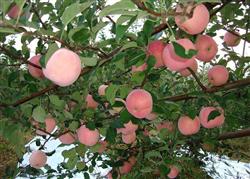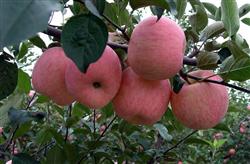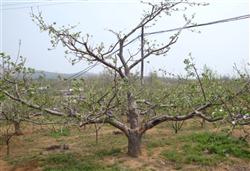How to manage red Fuji apple fat water

How to manage red Fuji apple fat water? Please guide the red Fuji orchard, generally in late September to apply the best base fertilizer, mainly soil miscellaneous fertilizer, yield less than 2000 kg per mu young orchard to kg fruit 2~3 kg fertilizer shall prevail, yield 2000~3000 kg per mu high-yield orchard to kg fruit kg fertilizer shall prevail, yield more than 3000 kg per mu high-yield orchard to kg fruit kg fertilizer shall prevail. When applying fertilizer, the ratio of N ∶ P ∶ K was 2∶1∶0 before fruiting, 2∶2∶1.5 at fruiting stage, 2∶2∶4 at full fruiting stage, and 2∶2∶1 after 15~16 years. In terms of fertilization methods, young trees can be applied in holes and furrows, adult trees can be applied in furrows or the whole garden. When fertilizing, attention should be paid to mixing fertilizer with soil, and fertilizer should be applied to the root system, mainly distributed in the layer (about 40 cm). For newly planted young trees, fertilizer should be applied from the second year, combined with basal fertilizer, deep ploughing of orchard can be carried out once, deep ploughing of tree tray can be carried out year by year, and deep ploughing of the whole garden should be carried out. The depth is 40∶60 cm. Applying topdressing, young trees could supply medium and short shoot bud differentiation and accumulate stored nutrients during spring shoot growth and autumn shoot growth. Prevent excessive growth, promote differentiation, reduce consumption and expand accumulation. The results showed that the first topdressing of N and P before budding in March (0.5 kg urea per plant) could promote flowering pollination, fruit setting rate, growth of spring shoots, fruit expansion and flower bud differentiation, yield and quality, and the second topdressing of N and P in the middle of June could promote fruit setting and stop growth of spring shoots in time, which was beneficial to flower formation and fruit development. Foliar fertilizer can be sprayed every 10 days from about 10 days after flowering. The mixture of urea and potassium dihydrogen phosphate (each half) can be sprayed for 3~4 times continuously to promote early leaf emergence. Spraying P fertilizer four times continuously within one and a half months before fruit harvest can promote fruit coloring, improve flavor and quality. Spraying N fertilizer and P potassium fertilizer twice continuously after fruit harvest can prevent leaf senescence, improve leaf function and strengthen organic nutrition production and storage of buds. The effect of reducing leaf premature drop is obvious. The optimum temperature for spraying fertilizer is 18℃~25℃. It is best to spray fertilizer before 11:00 a.m. and after 3:00 p.m. in summer to avoid high temperature. In case of phytotoxicity, fertilizer spraying should be careful and thoughtful, and the front and back of leaves should be sprayed evenly, especially the back of leaves absorbs quickly. In order to improve the absorption rate of nutrients, adhesive agents can be added to the sprayed nutrient solution, such as neutral washing powder, etc. After spraying, rain will seriously affect the effect, and timely supplementary spraying should be carried out. According to the determination, if it rains 8 hours after spraying, the urea left on the leaves can be washed away by 80%~90%, and the back of leaves can be washed away by 40%~60%. 2. Water management The water requirement of fruit trees can be divided into three stages in a year, the first stage is from March to the middle of May, the second stage is from the late May to the early August, and the third stage is after the middle of August. Before spring germination (March), combined with topdressing and appropriate irrigation, it is beneficial to stabilize and improve the ground temperature, promote the growth of shoots and leaves, flower setting and fruit development, so as to achieve the purpose of relatively controlling vegetative growth, promoting flower bud differentiation and improving fruit quality. Winter water can be poured once before freezing in November. For dry land orchard without watering condition, winter fallow season can be used to transport water to irrigate trees. At present, the technical measures adopted in orchard such as mulching, planting grass, covering grass, storing fertilizer and covering plastic film in holes, using soil water retention agent, etc. are economical and practical for regulating water consumption, and the effect is remarkable. Click for more apple tree growing techniques Click for more fruit growing techniques
- Prev

Red Fuji apple why rotten fruit
Why Red Apple? Fuji rotten fruit is caused by a variety of reasons, to find the reasons for comprehensive control to see the effect. 1. Causes of rotten fruit 1. Excessive girdling and overweight. Most fruit growers mistakenly believe that red Fuji apples cannot achieve the purpose of flowering without girdling, and will not be available in the coming year.
- Next

How to cut red Fuji apple trees in winter?
How to cut red Fuji apple trees in winter? Please guide the red Fuji apple tree to pay attention to when cutting in winter: 1. The plant height after pruning is less than the row spacing, and the interrow must be kept 1. 0-1. In the light transmission zone of 3 meters, the big branches of the plants do not cross each other, and the backbone branches of all levels are staggered with each other. The leaf curtain spacing of 30-50 cm should be maintained between the main branches of each layer to enhance the light.
Related
- Moge, come on! The staff of the peasant association in the producing area of cantaloupe were frightened when the crowd gathered.
- Causes and Solutions of low Fruit setting rate of Apple
- Symptoms and control measures of passion fruit virus disease
- Fruit growing lesson: how do apple orchards keep high yields?
- Can you build orchards in the mountains? What are the pros and cons?
- How to manage the coloring period of Crisson grape?
- This paper introduces the processing technology of two kinds of fig products.
- How much is a month for retired teachers in rural areas by 2020?
- How can strawberry planting increase sugar content? We should pay attention to management in many aspects.
- What are the cultivation techniques on how to improve the yield of golden fruit?

